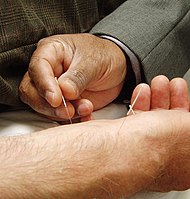
Photo from wikipedia
Objective: To assess the effectiveness of acupuncture for non-specific low back pain (NSLBP) through systematic review of published randomised controlled trials (RCTs). Methods: Studies were identified in electronic databases from… Click to show full abstract
Objective: To assess the effectiveness of acupuncture for non-specific low back pain (NSLBP) through systematic review of published randomised controlled trials (RCTs). Methods: Studies were identified in electronic databases from their inception to February 2018, and were grouped according to the control interventions. The outcomes of interest were pain intensity and disability. Methodological quality was evaluated using the Cochrane risk-of-bias criteria and the Standards for Reporting Interventions in Controlled Trials of Acupuncture (STRICTA) checklist. The review was reported according to the PRISMA (Preferred Reporting Items for Systematic Reviews and Meta-Analyses) guidelines. Results: 25 trials (n=7587 participants) were identified and included in a meta-analysis. The results showed that acupuncture was more effective at inducing pain relief than: no treatment (standardised mean difference (SMD) −0.69, 95% CI −0.99 to −0.38); sham acupuncture in the immediate term (SMD −0.33, 95% CI −0.49 to −0.18), short term (SMD −0.47, 95% CI −0.77 to −0.17), and intermediate term (SMD −0.17, 95% CI −0.28 to −0.05); and usual care in the short term (SMD −1.07, 95% CI −1.81 to −0.33) and intermediate term (SMD −0.43, 95% CI −0.77 to −0.10). Also, adjunctive acupuncture with usual care was more effective than usual care alone at all time points studied. With regard to functional improvement, the analysis showed a significant difference between acupuncture and no treatment (SMD −0.94, 95% CI −1.57 to −0.30), whereas the other control therapies could not be assessed. Conclusion: We draw a cautious conclusion that acupuncture appears to be effective for NSLBP and that acupuncture may be an important supplement to usual care in the management of NSLBP.
Journal Title: Acupuncture in Medicine
Year Published: 2020
Link to full text (if available)
Share on Social Media: Sign Up to like & get
recommendations!